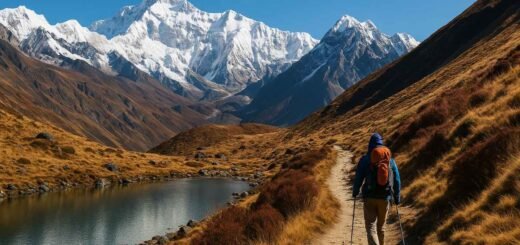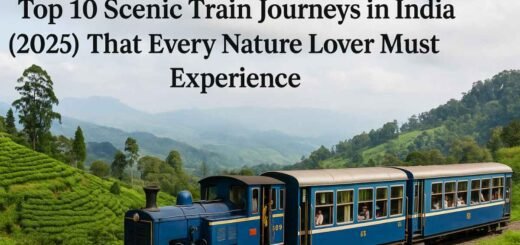Off-Beat India Destinations: 10 Must-Visit Hidden Gems You’ll Love
Off-beat India destinations await your discovery — explore hidden gems, immersive travel and unique experiences. Start planning now!
Off-beat India destinations open a world beyond the usual circuit. From tranquil villages to lesser-known temples and scenic landscapes, these hidden gems invite you to explore authentic India, unhurried and rich.
Contents
- 1 Quick Facts at a Glance
- 2 1. Yana, Karnataka
- 3 2. Gokarna, Karnataka
- 4 3. Hampi, Karnataka
- 5 4. Shillong, Meghalaya
- 6 5. Leh/Ladakh, Jammu & Kashmir
- 7 6. Jaisalmer, Rajasthan
- 8 7. Kaas Plateau, Maharashtra
- 9 8. Udaipur, Rajasthan
- 10 9. Kerala Backwaters (Alleppy & Beyond)
- 11 10. Darjeeling & Surrounds, West Bengal
- 12 Best Time to Visit
- 13 How to Reach
- 14 Seasonal Travel Insights
- 15 Local Cuisine & Food to Try
- 16 Where to Stay
- 17 Shopping & Souvenirs
- 18 Travel Tips
- 19 FAQs
Quick Facts at a Glance
- Number of destinations covered: 10
- Geographic spread: North, South, East & West India
- Ideal travel style: Slow travel, immersive experiences, off-tourist-path
- Typical season: Shoulder seasons (Oct–Nov, Feb–Apr)
- Budget note: Mid-range to budget friendly, local stays preferred
1. Yana, Karnataka
Located in the Malenadu region of Uttara Kannada, Yana is famed for its two massive limestone rock outcrops — the Bhairaveshwara Shikhara (approx 120 m) and Mohini Shikhara (approx 90 m).
Why visit
- Trek through lush forest to reach these dramatic rock formations.
- A quiet village setting, off the mainstream tourist map.
Travel tip
Wear good walking shoes; local transport options are limited. Visit early morning for cooler weather.
Best for
Nature-lovers, light trekking, off-beat south India.
2. Gokarna, Karnataka
Often overshadowed by neighbouring Goa, Gokarna is a temple town and beach destination on the Arabian Sea coast.
Why visit
- Combines spirituality (Mahabaleshwara temple) with relaxed beach vibes.
- Coastal trails linking beaches offer scenic but less-crowded walks.
Travel tip
Avoid peak holiday weekends if you want solitude. Choose a beachside cabin for minimalism.
Best for
Beach seekers, backpackers, those wanting spiritual + seaside mix.
3. Hampi, Karnataka
Described as “Jurassic Park meets The Flintstones with huge boulders you can just picture dinosaurs walking through!” in one travel write-up.
Why visit
- UNESCO heritage site with ruins, temples and surreal rock-scapes.
- Excellent for photography, history, and adventure walks.
Travel tip
Rent a bicycle or scooter to explore across the valley; sunrise at the river is magical.
Best for
Photographers, history buffs, adventure travellers.
4. Shillong, Meghalaya
Recently emerged as India’s most-searched travel destination according to Skyscanner (2025) thanks to its natural beauty and vibrant local culture.
Why visit
- Lush hills, dramatic waterfalls and a refreshing change from plains.
- Local Khasi culture, markets and forest trails give a genuine experience.
Travel tip
Weather can turn quickly in the hills — pack a light rain-jacket. Night markets are fun.
Best for
Nature lovers, culture seekers, off-tourist-circuit travellers.
5. Leh/Ladakh, Jammu & Kashmir
High-altitude, remote and dramatic — Ladakh offers landscapes that many describe as other-worldly.
Why visit
- Snow-peaks, glacial lakes, Buddhist monasteries and desert-valley landscapes.
- Ideal for adventure: trekking, motor-bike routes, camping under stars.
Travel tip
Acclimatize gradually due to altitude (~3500 m+). Avoid monsoon (July) and winter (roads closed) in many parts.
Best for
Adventure travellers, photographers, remote-destination lovers.
6. Jaisalmer, Rajasthan
One of the more popular “hidden gems” — a desert city that still feels remote and magical.
Why visit
- Golden-hued old city, legendary fort, and camel-safari in the Thar Desert.
- Starry night desert camps, folk music, and timeless ambience.
Travel tip
Take a sunset camel ride. Ensure you choose certified guides for desert safety.
Best for
Romantic travellers, desert-camp enthusiasts, culture & history fans.
7. Kaas Plateau, Maharashtra
A magical monsoon destination: during late August to early October it bursts into a carpet of wildflowers.
Why visit
- Over 850 species of flowering plants bloom in misty monsoon landscape.
- Quiet, regulated access makes it ideal for contemplative nature time.
Travel tip
Visit early in season for full bloom. Carry water and anti-slip footwear due to wet terrain.
Best for
Nature photographers, botanical lovers, serene travel experiences.
8. Udaipur, Rajasthan
A romantic lakeside city with palaces and charm, sometimes overlooked in favour of bigger Rajasthan destinations.
Why visit
- Elegant palaces, boat rides on Lake Pichola, and cobbled old-town lanes.
- Great base for exploring Rajasthan’s history in a relaxed way.
Travel tip
Stay in a heritage hotel with lake view for true experience; carry a scarf for temple visits.
Best for
Couples, luxury-leaning travellers, culture & history fans.
9. Kerala Backwaters (Alleppy & Beyond)
South India’s lush, tranquil side — houseboats, calm waters, village life. Mentioned as among the “best places to visit in India”.
Why visit
- Slow-pace boat ride through palms and canals, observing local life.
- Good alternative to beach holiday for quiet immersion.
Travel tip
Choose off-peak times for less crowds. Respect local village norms and quiet hours.
Best for
Families, honeymooners, travellers seeking peace & nature.
10. Darjeeling & Surrounds, West Bengal
A hill station with tea-fields, panoramic mountain views and a colonial-era charm.
Why visit
- Cool climate, lush tea gardens, early-morning Himalayan views.
- Off the usual south India beach circuit, offers a distinct mountain vibe.
Travel tip
Check sunrise timing for mountain views. Book accommodation early during festive months.
Best for
Hill station fans, photo-enthusiasts, nature & tea culture lovers.
Best Time to Visit
- October–November: Shoulder season across most of India — pleasant weather, fewer crowds.
- February–April: Clear skies, good for hills & deserts.
- Avoid May–July in many regions: intense heat or monsoon rains.
- For Kaas Plateau: Late August–Early October for wildflower bloom.
- For high altitudes (Ladakh): ~June–September window.
How to Reach
- Major cities (Delhi, Mumbai, Bengaluru) have international airports; local hubs serve these hidden gems.
- Trains and buses connect many; remote areas (Ladakh, plateau regions) require planning ahead.
- Recommend internal flights for distant legs + local transport (taxis, scooters).
- Always check road/rail connectivity if visiting off-beat areas.
Seasonal Travel Insights
- Hills become cooler and misty; pack layers.
- Desert (Jaisalmer) hot in daytime but chill at night — bring sun protection and warm jacket.
- Monsoon-areas (Kaas, Kerala) may face rainfall — waterproof gear essential.
- Altitude factors: Ladakh’s nights get cold; acclimatization matters.
Local Cuisine & Food to Try
- Karnataka (Yana/Gokarna): Coastal seafood, Malnad specialities (rice-plates).
- Rajasthan (Jaisalmer/Udaipur): Dal Baati, ghewar (seasonal), local sweets.
- Meghalaya (Shillong): Khasi cuisine — smoked meats, bamboo shoot dishes.
- Kerala Backwaters: Onam Sadhya (traditional vegetarian feast), fresh fish curry.
- Darjeeling: Nepali & Tibetan influenced cuisine — momos, thukpa, Darjeeling tea.
Where to Stay
- In off-beat areas: Guesthouses, homestays offer authentic feel and good value.
- Heritage hotels (Udaipur, Jaisalmer) for luxury + history.
- Hill regions (Shillong, Darjeeling): Book early in peak season.
- Boat-stay in Kerala Backwaters: Unique experience but check amenities.
- Caravan/camps in desert (Jaisalmer): Ensure safety and comfortable gear.
Shopping & Souvenirs
- Yana/Gokarna: Hand-loom Karnataka fabrics, local woods.
- Rajasthan: Rajasthani textiles, miniature paintings, blue pottery, local handicrafts.
- Meghalaya: Hand-woven shawls, Khasi jewellery.
- Kerala: Spices (cardamom, pepper), coir products, tea from Darjeeling.
- Desert camps: Local folk crafts, camel leather items (check authenticity).
Travel Tips
- Respect local customs: modest dress especially in temples/villages.
- Start early for hikes or desert rides (cooler temps).
- Carry cash when travelling remote areas; ATMs may be sparse.
- Always check weather/road conditions for remote destinations.
- Travel insurance strongly recommended for high-altitude/trek trips.
FAQs
Q1: What defines an “off-beat India destination”?
It means places less crowded, not typical major tourist hubs, offering deeper local experiences rather than standard mass itinerary tours.
Q2: When is the best time to visit off-beat destinations like Yana or Gokarna?
Usually in the shoulder seasons (Oct–Nov or Feb–Apr) when weather is pleasant and crowds moderate.
Q3: Are these places safe for solo travellers, especially women?
Generally yes, if standard travel precautions are taken; discreet dress and common-sense behaviours help.
Q4: Which of these destinations are budget-friendly?
Many are — guesthouses/homestays in Karnataka, Meghalaya and even desert camps can fit modest budgets. Heritage hotels/camps raise costs.
Q5: How do I travel between remote off-beat destinations?
Combination of flights (to nearest major hub) + trains/buses / hired car for local legs. Road travel planning is key in remote areas.
Q6: Is it feasible to cover several of these destinations in one trip?
Yes — but allow 2-3 weeks; consider cluster travel (e.g., Karnataka beach + plateau) rather than disjointed across India to reduce travel fatigue.
Explore off-beat India destinations and discover quieter corners of this vast country. From Yana’s dramatic rock forests to Kerala’s peaceful backwaters, each offers a distinctive travel memory. Let hidden gems become your next adventure — off-beat India awaits!
Useful Links
- India Travel Guide: everything you need to know
- 30 Best Places to Visit in India
- Coastal Odisha Road Trip
Author
Name: Prayanamam


